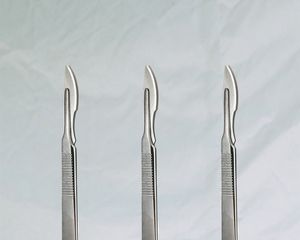
Stocksy
We’ve come a long way when it comes to cosmetic procedures. Long gone are the days of incredibly invasive surgeries that would take weeks, if not months, to recover from, the days of *too* drastic results, the days of cosmetic procedures being for the ultra-wealthy. Now it’s as simple as going to a clinic during your lunch break to get a little refresh.
But sometimes, you might need a little bit more than a touch-up on your Botox or fillers. Maybe you’ve recently lost a lot of weight and have noticed a sagging jawline, or maybe you’re looking for an in-between fix before you spring for a full face-lift. Thankfully, there’s an option, and it’s called a mini face-lift.
We spoke with board-certified plastic surgeons Samuel Lin, MD, and Alexis Parcells, MD, and board-certified nurse practitioner Vanessa Coppola to get all the details about mini face-lifts, including questions to ask and aftercare procedures. Keep reading to learn all about mini face-lifts, below.
Meet the Expert
- Samuel Lin, MD, is a board-certified plastic surgeon and associate professor of surgery at Harvard Medical School.
- Alexis Parcells, MD, is the owner of Parcells Plastic Surgery and founder of SUNNIE Wrinkle Reducing Studio.
- Vanessa Coppola is a board-certified nurse practitioner, aesthetic specialist, and owner of Bare Aesthetic Medical Spa.
What Is a Mini Face-Lift?
To make a long story short, a mini face-lift is the less invasive version of a full face-lift. It’s sometimes called the “ponytail lift,” the “weekend face-lift,” or the “lunchtime facial,” as it’s a relatively quick procedure that offers less downtime than its counterpart. It helps address sagging jawlines and cheeks, but in a more subtle way. “A mini facelift is also called a short scar face-lift,” explains Samuel Lin, MD. “A mini face-lift is a surgery to address loose skin and signs of aging in the midface (the area between the corners of the eye and the corners of the mouth) and jowls. A mini face-lift is a modified version of a traditional face-lift, with a series of small incisions along the hairline to correct the appearance of sagging skin that typically is around the neck and jawline.”
Typically, a mini face-lift is not as invasive as a regular face-lift, but you will have to undergo anesthesia. Vanessa Coppola explains, “It is a surgical procedure requiring anesthesia. However, it is often done on a same-day basis and with a shorter recovery time than a traditional face-lift. Mini face-lifts typically involve a shorter incision that begins at the temple and extends down in front of the earlobe. Once the skin is opened, the underlying tissues are repositioned and tightened, and excess skin is trimmed away. The shorter scar, quicker recovery time, and lower face rejuvenation are fairly common with the mini face-lift, but techniques vary widely.”
It’s important to note that a mini face-lift is not a permanent solution. Results typically last anywhere from five to 10 years.
Benefits of a Mini Face-Lift
- Shorter recovery time
- Smaller/shorter scars
- Can lift and contour the face more than Botox and fillers alone
- Long-lasting results
- Minimal pain
If you have a sagging jawline and cheeks that fillers and Botox alone can’t fix, a mini face-lift might be a great option for you. “Mini face-lift surgery is one of the highest satisfaction rates out of all plastic surgery procedures," says Alexis Parcells, MD. “Patients look and feel younger and oftentimes have a very short recovery and downtime with minimal pain. For faces that qualify for a mini face-lift, it is a little bit less expensive than a full face-lift, and the recovery time is a little bit shorter because it's less of a recovery for the neck portion.”
However, you should know that a mini face-lift alone won’t address all of your facial aesthetic needs. Coppola points out that you might still need to use Botox and fillers to achieve the final look you want, but since your foundation is lifted, you’ll likely achieve a more aesthetically pleasing result.
How to Prepare for a Mini Face-Lift
If you’ve been debating getting a mini face-lift, there are a number of questions you should ask before you schedule your procedure. Unlike cosmetic procedures like fillers and Botox, a mini face-lift is considered a surgery, and it’s incredibly important to assess the major risks of the procedure. “The most important question is to check that the surgeon is properly credentialed and board-certified and has performed the procedure many, many times. You want to know whether they have a surgical office in-suite or they operate in the hospital, and what are the specific requirements of each,” explains Coppola. “You will want to ask what type of anesthesia will be administered and who is the anesthesiologist. You will want to see many before-and-after photos and ask specific questions about the surgical techniques performed, the layers of tissue involved, for example, SMAS or superficial layers only, or a combination. This will affect the results as well as the recovery period.”
Once you’ve scheduled your appointment, Parcells recommends avoiding any medication or supplements that can lead to bleeding for at least two weeks before the procedure. Lin adds, “The precautions to take before surgery can depend on the type of anesthesia used, and your surgeon will provide you with instructions. If you smoke, quitting smoking several weeks prior to your surgery is important for optimal healing.” And finally, make sure that you don’t drink or eat at least six hours before your treatment to avoid nausea and vomiting from the anesthesia.
What to Expect During a Mini Face-Lift
While a mini face-lift might not be as invasive as a regular face-lift, it’s important to remember that it’s still a major surgery. If you’ve had any sort of previous surgery, you’ll know that the nerves can be real. Try to practice meditation or listen to your favorite music or podcast to help calm your nerves before your surgery. Before the procedure, you’ll typically be given both local and general anesthesia to sedate you. Lin explained that “during a mini face-lift surgery, the surgeon makes an incision right in front of the ear in order to address loose skin and tighten tissue located just below the skin. Excess skin will be removed, and the remaining skin is redraped. Then, the incision is closed so that the scar is hidden just in front of the ear. Overall, the surgery takes around two hours.”
Your surgeon will typically provide you with an antibiotic and pain medication. You should take each as directed by your doctor. Also, according to Lin, you’re likely to go home with bandages on your face, and may have drains that will need to be removed after about 48 hours.
Face-Lifts vs. Mini Face-Lift
Sobel explained to us that a mini face-lift is a less invasive version of a regular face-lift that targets the jowls and upper neck regions, while a full face-lift includes the midface and full neck. Another big difference? A mini face-lift has a shorter scar. “A mini face-lift results in a shorter scar than a regular face-lift. In a mini face-lift, there is only a scar in front of the ear. In a regular face-lift, the scar extends around the bottom of the earlobe and behind the ear,” explains Lin. “Because the scar is shorter in a mini face-lift, a mini face-lift cannot lift skin around the neck as well as a regular face-lift. A mini face-lift is best for patients who have minimal loose skin around the neck but desire improvement in the midface and jowls.”
Typically, face-lifts are done on those who are older, or who have had significant weight loss in the face. Parcells adds, “A mini face-lift is performed in younger patients who have been weight stable, have good skin laxity and tone, and need a small to moderate overall improvement.”
Potential Side Effects
After your surgery, it’s common to experience swelling, discomfort, and bruising. Complications from a mini face-lift are rare and are typical of any common surgery. “Complications are those that can arise from any surgical procedure and include the formation of a hematoma, swelling, infection at the surgical site, loss of circulatory supply to the new repositioned tissues, persistent numbness to the surgical site, and scarring,” says Coppola. “Some of these are expected, such as swelling, bruising, and transient numbness, but should subside in a few weeks.” And while rare, there is also the risk of damaging facial nerves. Parcells adds, “The main risk is that you're close to the facial nerve—the nerves that innervate all the muscles of the face.”
Also, scarring, while rare, could be a possible side effect. Parcells explained to us that anytime you make an incision to the skin, there's a risk of unsightly scarring.
The Cost
A mini face-lift is typically less expensive than a full face-lift, but the cost can vary dramatically depending on your location and surgeon. Typically, you’re looking at paying anywhere from $3,000 to $8,000, which also includes the type of anesthesia used, the surgeon’s fees, and any hospital fees.
Aftercare
After your mini face-lift, you won’t need to stay in the hospital or surgery center and are free to go home. You won’t be able to drive after the surgery, so it’s a good idea to enlist a good friend or family member to help you get home safely and help you with your recovery for the next 24 hours. Also, you won’t be able to work for at least one to three weeks afterward, so it’s a good idea to factor that into your aftercare plan as well.
Sobel told us to keep in mind that the recovery process looks different for every person and that “rest and minimal activity are the biggest components for a smooth recovery, as well as icing the area to reduce any swelling and bruising.” Lin adds, “You will need to see your surgeon the morning after surgery and several other times to monitor your healing. Sutures are usually removed one week after surgery. For the first two weeks, lifting and bending are strictly limited, and strenuous exercise should be avoided for the first six weeks after surgery. Most patients feel ready to return to work after 1–3 weeks.”
The Final Takeaway
A mini face-lift is a great option for people who want a natural-looking result with much less downtime than the traditional face-lift. If your sagging jawline and cheeks can’t be treated with cosmetic procedures like Botox and fillers, a mini face-lift is an option you might want to consider. But remember, even though it’s not as invasive as a regular face-lift, it is still considered a major surgery, so it’s important to choose a surgeon who is board-certified and has extensive experience with the procedure.

















